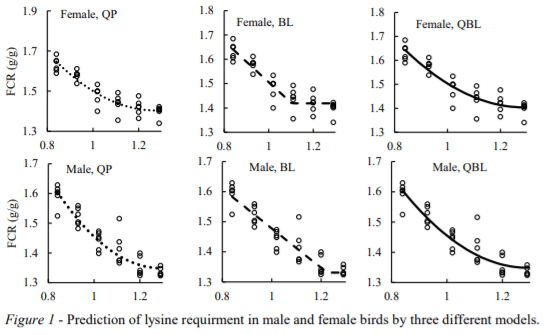Prediction of Digestible Lysine Requirement in Broiler Chickens from 14 to 35 Days Post-Hatch by Three Different Models
Published: June 14, 2021
By: S.Y. LIU 1, C.W. MAYNARD 2, S.J. ROCHELL 2, J. CALDAS 3 and M.T. KIDD 2. / 1 Poultry Research Foundation, The University of Sydney, Camden NSW, Australia; 2 Center of Excellence for Poultry Science, University of Arkansas, Fayetteville, AR 72701, United States; 3 Cobb-Vantress, Inc, Siloam Springs, AR 72761, United States.
Accurate estimation of the broiler’s lysine (Lys) requirement is vital because it is the second limiting amino acid (AA) in poultry diets and, when the ideal protein ratio concept is applied, the essential amino acids (EAA) are expressed as ratios to Lys. It is necessary to regularly update AA requirements for modern broiler chickens in order to accommodate their genetic progress. However, defining a nutrient requirement is difficult because of variations in age and sex of animals and choice of statistical response models (Baker, 1986). The present study compared three statistical models evaluating the digestible (dig) Lys response for growth performance of male and female Cobb MV × 500 broilers during the grower phase.
Dietary treatments consisted of 6 concentrations of dig Lys ranging from 0.84 to 1.29 % in increments of 0.09%. Experimental diets were based on maize, soybean meal and peanut meal. All diets were balanced for EAA by using the ideal protein ratio approach. Each of the 6 diets was offered to both male and female broilers from 14-35 days post-hatch and each treatment was offered to 6 floor pens with 12 birds per pen or a total of 864 birds. Three models, including quadratic polynomial (QP), linear broken-line (LB) and quadratic broken-line (QBL), were fitted to estimate the optimal level of dig Lys to maximize broiler growth performance.
In male birds, the Lys requirement for maximum weight gain was 1.03% (BL model), 1.14% (QBL) and 1.13% (QP). In female birds, the Lys requirement for maximum weight gain was 1.15% (BL) and 1.29% (QBL) but the QP model was not significant. The dig Lys requirement for optimal FCR using the QP model was estimated to be 1.21 % for females and 1.23% for males. However, the BL model predicted that the dig Lys requirement for optimal FCR was 1.10 % for females and 1.22% for males; whereas, for QBL model, the dig Lys requirement for optimal FCR was 1.29% for both male and female birds. In general, the BL model generated the lowest dig Lys requirement in comparison to the QP and QBL models. Also, the optimal dietary dig Lys concentration for maximal profit may differ due to fluctuations in ingredient and chicken meat prices. Therefore, the dietary dig Lys recommendations reported in the literature should be applied with caution in practice.

Abstract presented at the 30th Annual Australian Poultry Science Symposium 2019. For information on the latest edition and future events, check out https://www.apss2021.com.au/.
References
Baker DH (1986) Journal of Nutrition 116: 2339-2349.
Related topics:
Authors:
The University of Sydney
Auburn University
Aviagen
University of Arkansas (USA)
Show more
Recommend
Comment
Share

Would you like to discuss another topic? Create a new post to engage with experts in the community.











.jpg&w=3840&q=75)